8 Days in Cuba: Vinales, Trinidad and Havana
Prior to arriving in Cuba, we’d heard so many whispers of poor travel experiences. Expensive transport. Average food. Everyone is running late. When we arrived in Cuba – after 12 days in Colombia – we couldn’t wait to experience Cuba for ourselves.
Were the rumours true? Was travelling in Cuba just as hard as everyone made it out to be? Keeping in mind we’re from Australia (things might be harder if you’re from the United States), here’s how our trip to Cuba went.
Surprise and delight upon arrival in Cuba
Towards the end of our flight from Bogota to Havana, I looked out the window to see bright blue reef systems in the ocean below us, then perfect crop circles in rural Cuba.
Getting through customs took us no time at all, and our bags came out in less than 25 minutes. We didn’t have to declare a thing upon entry, and we weren’t asked to show proof of travel insurance. So far, Cuba was completely shattering all our expectations.
Accessing money didn’t end up being a problem, either. We had no troubles using the ATM inside Cuba’s international airport.
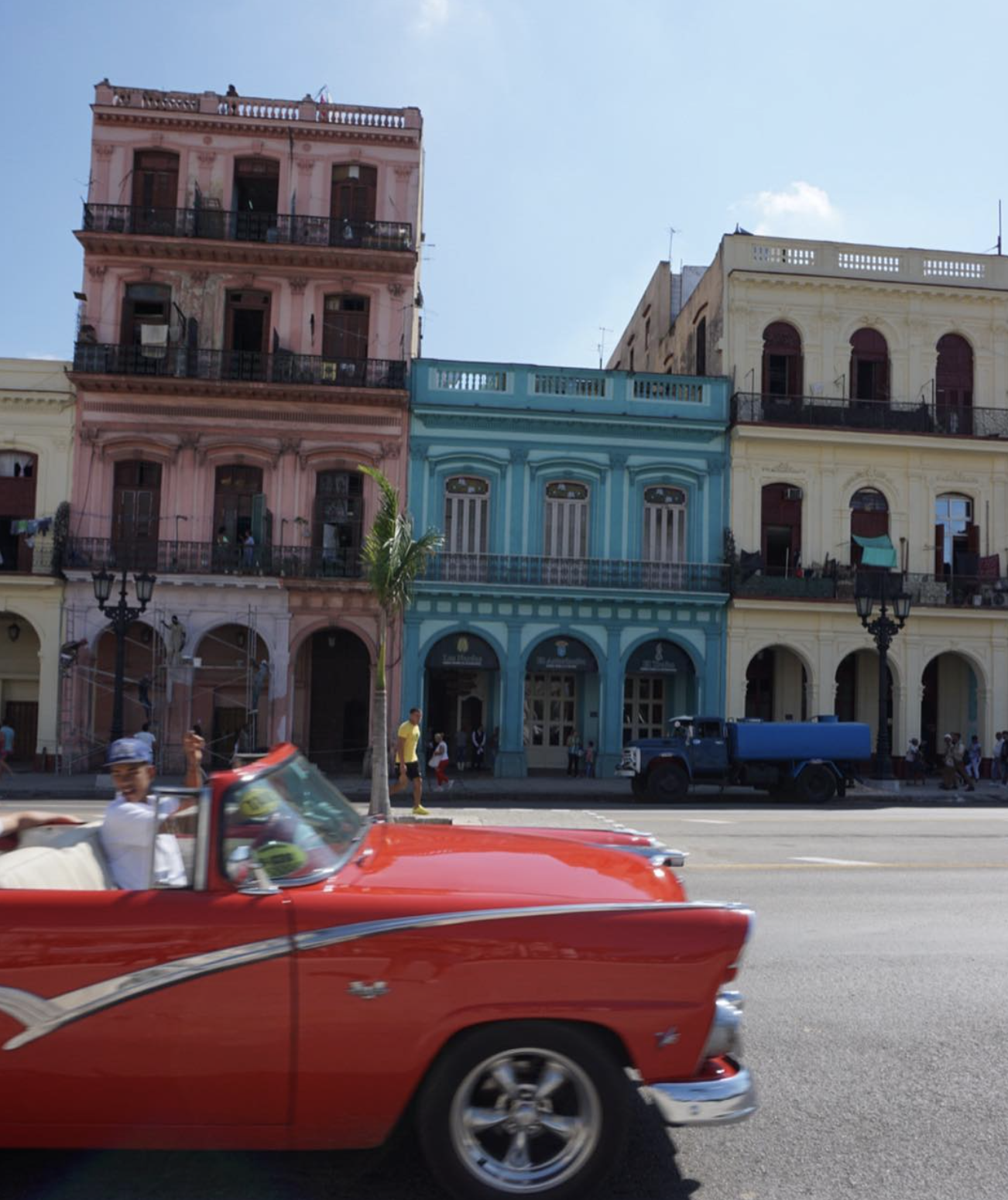
An afternoon in Havana
When we arrived at our hostel (Hostal Red, Havana) it felt like we were meeting a long-lost uncle for the first time. Casa owner and Red Hot Chili Peppers look-alike, Roberto, welcomed us to his home with a big hug.
His young daughter was patting a fluffy white rabbit while she introduced us to their pet German Shepherd, Princessa. Roberto’s wife handed us each a glass of juice, and showed us to our shared room upstairs.
The spacious room had pale green walls, patterned brown tiles on the floor, and our beds were all neatly made. I stopped to take a good look at the giant map of Cuba they had pinned to the wall, when it dawned on me that our plan to see Vinales and Trinidad might be a stretch with just 8 days. Havana sits between these two destinations, and to get buses to and from each place, we’d have to come back to Havana before continuing our journey.
There were warm smiles all around as we sat in the living room and spoke broken Spanish, while awkwardly laughing and hoping they hadn’t asked us a question that required something other than “si” as a response.
We took a walk around Vedado neighbourhood and grabbed lunch at La Cathedral, a large red building where waiters wearing black suits and red ties politely served us. We ordered a giant Margherita pizza and spaghetti bolognese for 10.70 CUC. Contrary to what everyone says about food in Cuba, our first meal was delicious.
We took a stroll along the Malecon to find a place where we could exchange CUC for CUP. The Malecon is covered with bits of coral and water from the ocean, probably from storms battering the coastline. I stepped into a puddle, and caught myself before falling onto the concrete.
Tip: treat some sections of the Malecon as though you’re walking along rock pools.
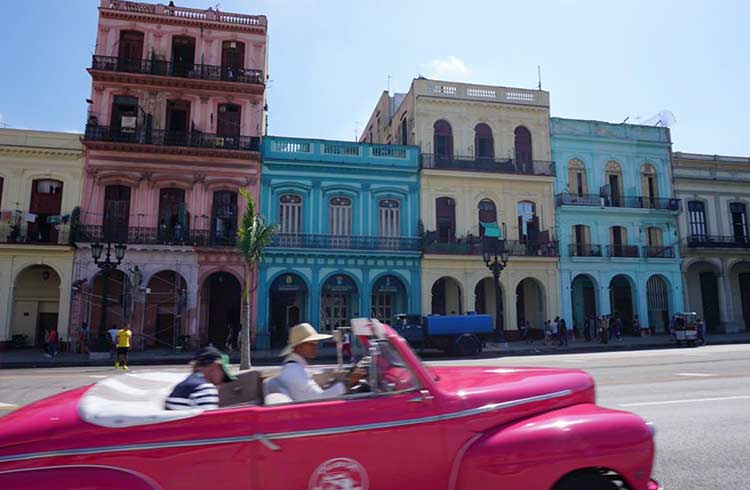
We were told by a traveller in Tayrona National Park that Copelia ice cream is the best place to have ice cream in Havana. Unfortunately, when we got there the line was far too long.
We went to the Caceda Exchange where we swapped 20 CUC for 480 CUP. We’d heard we could save a lot of money if we had some local currency.
As we strolled back down the street toward our hostel, we found a chocolate ice cream vendor operating out of their garage. The man handed us two cones through a barred window in exchange for 10CUP (approximately $0.50 AUD). While I can’t comment on Copelia ice cream, this small vendor absolutely delivered.
That night, a loud storm battered Havana. Overnight, Roberto or his wife took our towels off the washing line outside, placing them inside so they didn’t get wet.
That morning, we packed our daypacks with everything we needed for the next two days. We decided to leave our giant backpacks at the hostel, as we didn’t need all our belongings for a trip to Vinales Valley.
For breakfast, Roberto served us guava juice, coffee, warm bread, eggs with onion and capsicum, sliced tomato and fried banana. We all sat around the table talking until mid morning, when Mark and I decided we’d better get a move on and make our way to Vinales.
Travelling to Vinales Valley
What was supposed to happen: walk into town and catch a local bus to Pinar del Rio for 5CUC. Then, for 1CUC we would catch another local bus from Pinar del Rio to Vinales.
What did happen: we paid 5CUC for a taxi from the hostel to the bus station. We couldn’t find a local bus, and everyone we spoke to at the station told us there was no bus available. We quickly realised they didn’t want travellers catching their local transport. Fair enough.
Moving on. We caught an insanely overpriced coco taxi ride (12CUC) to the Viazul station. We were about to pay 12CUC for a comfortable bus ride 183km to Vinales, and paid the same price for a crappy little yellow nut-sack on wheels to take us a few kilometres up the street.
I stared out the window for what felt like the entire 183km journey from Havana to Vinales. As the bus drove by a farmer standing beside the road, I saw him holding up his rude finger to all the passengers. Embarrassingly, something Mark and I often do to tourist buses back home in Australia.
When we arrived in the town of Vinales later that afternoon, Mark and I navigated the streets of town to find Maceo y Gladys’s casa – which I had pre-booked using HostelWorld.
Tip: do not pre book any accommodation after your first few nights in Cuba. Your casa owner will hook you up with better accommodation wherever you go. If you book casas through booking websites, you might not get the authentic experience you were hoping for.
When we arrived at Gladys’s red gate to her bright pink house, she immediately handed us a glass of mango juice, sat us down and began poking at a piece of paper with over-priced tour information on it. We told her we wanted to go solo hiking in the valley, and weren’t interested in a tour, to which she said “No, you are not allowed.”
We declined her tour offers*. We would find a way to navigate our way through the tobacco fields ourselves. We could tell she wasn’t giving us the truth.
That night we went to Mogote Cafe for dinner. The restaurant overlooks the beautiful hills at sunset. For 15CUC we got a plate of pasta, an omelette and crazy fries, a white rum, coca cola and mango juice.
Vinales is a tourist town. One street is all casas, the other is all restaurants. It’s a beautiful place, but we could tell nobody genuinely wanted to help us out, they just wanted our money.
Hiking in the Vinales Valley without a guide
The next morning we woke to the sound of roosters crowing in the farms. We had no plans set in stone, we just wanted to go hiking. Without wi-fi, we have to trust the word of the Cuban people and Maps.Me, which I had wisely downloaded before we arrived in Cuba.
We walked into town for breakfast, hoping Gladys wouldn’t see us as we snuck out of her house. Cine Cafe served us up two omelettes and two cafe bombas (chocolate coffee) for about 10 CUC.
We navigated our way to Cueva de la Vaca, approximately 2km from town. We found a path at the end of a road towards the end of town. Heads up: you will be navigating through private property of tobacco farmers – which is at times unnerving when you’ve got no official guide.
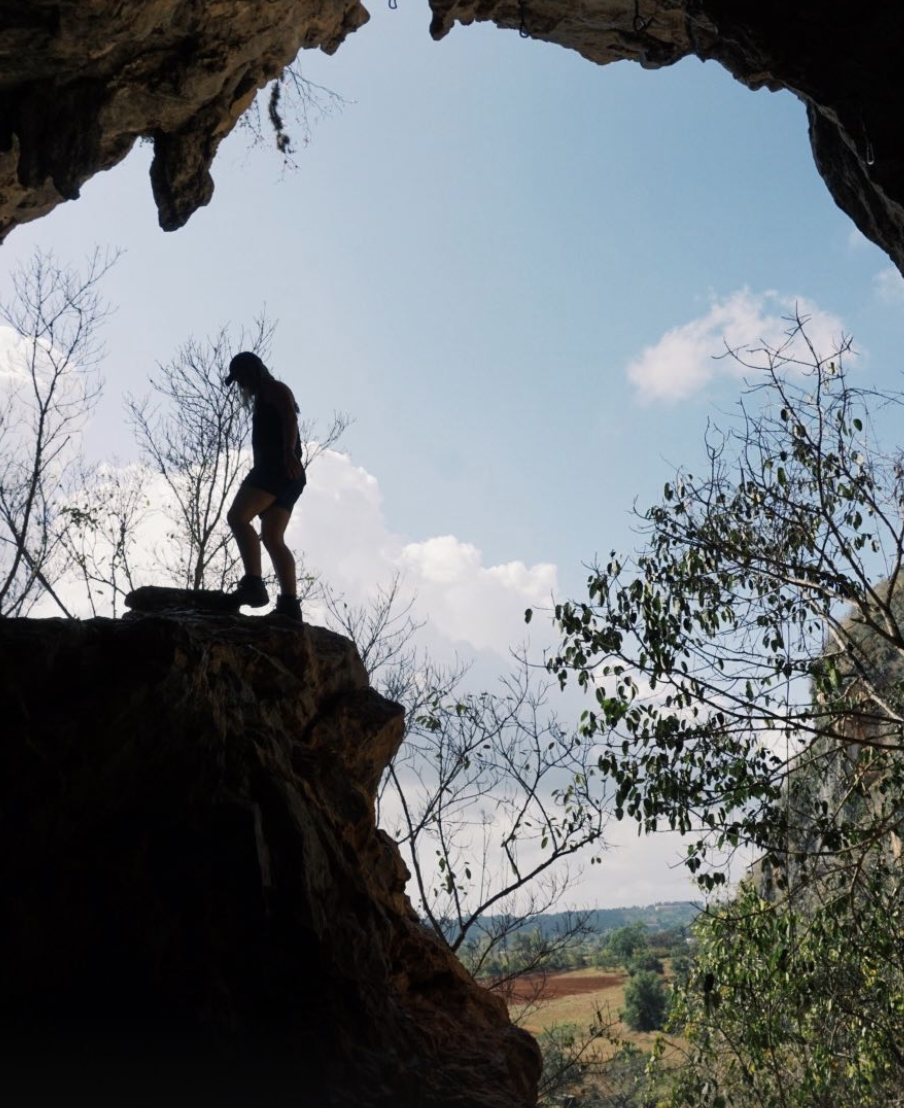
We saw stacks of tour groups along the way. The benefit of going with a tour is that you get a tour of the tobacco farms, but if you’re willing to miss out on learning about their farming, go hiking alone.
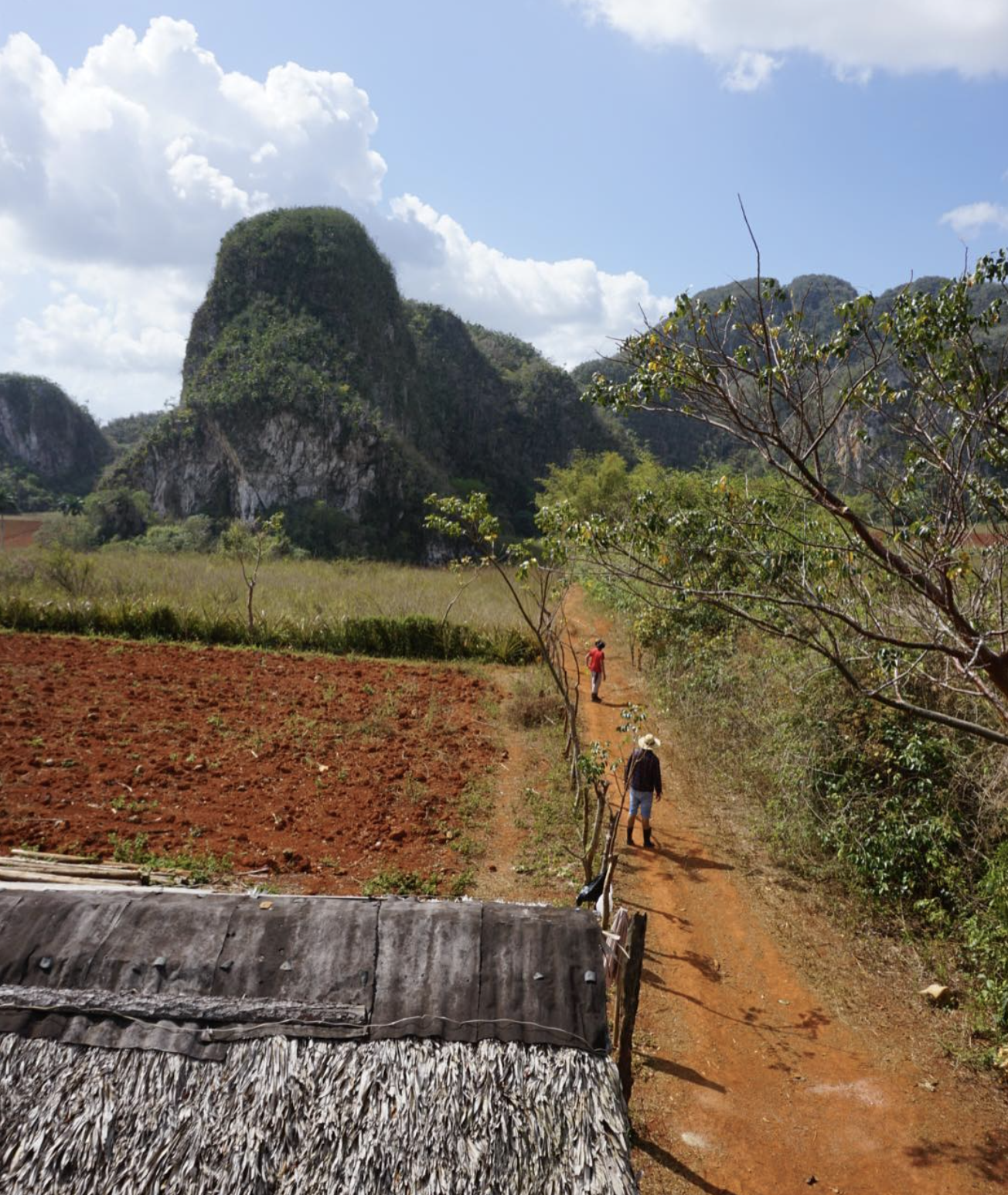
We climbed up a sketchy set of stairs to get inside Cueva de la Vaca, which overlooks the valley below. A street dog followed us up the steps, and seemed eager to join us further on our journey.
We walked through the cave that took us to an opening on the other side. We followed the steep path down, winding through overgrown bushes to get to the beginning of the valley hike. The valley opens up with a dirt path winding between tobacco fields. On Maps.Me it looked like a 4.3km walk to a mirrador (lookout), and we could see there would be a way to hike all the way to Mural de la Prehistorica.
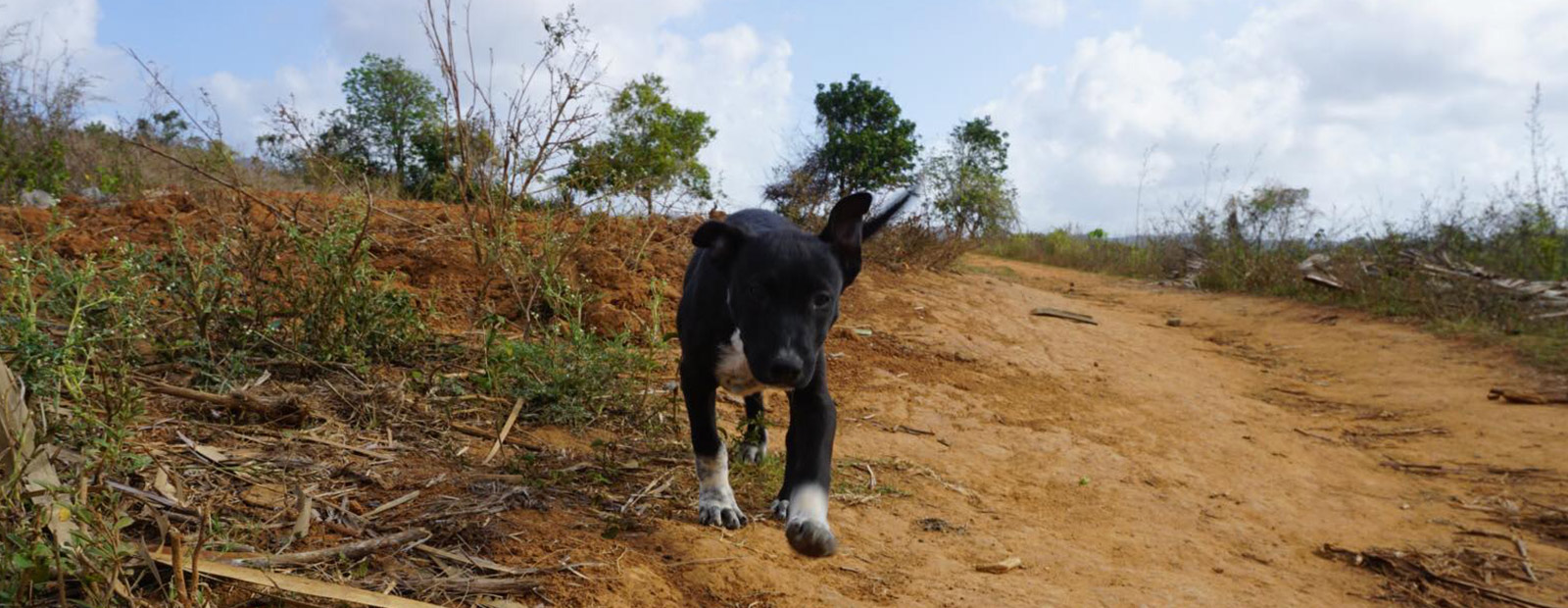
We walked through paddocks, opened and closed gates, hopped fences and took many wrong turns along the way. While walking in a paddock we realised we were on someones farmland when a cow appeared in front of us. We quickly got out of the paddock, and further up the road we saw an old man. We asked him if we were going the right way to get back to town. He nodded and smiled kindly, pointing in the direction we should continue.
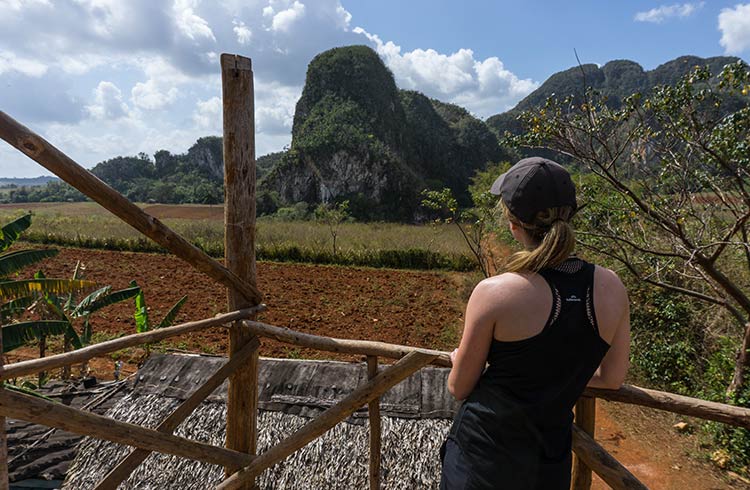
Finally, we reached Mural de la Prehistorica, a huge painted rock face with a cafe and tour busses outside.
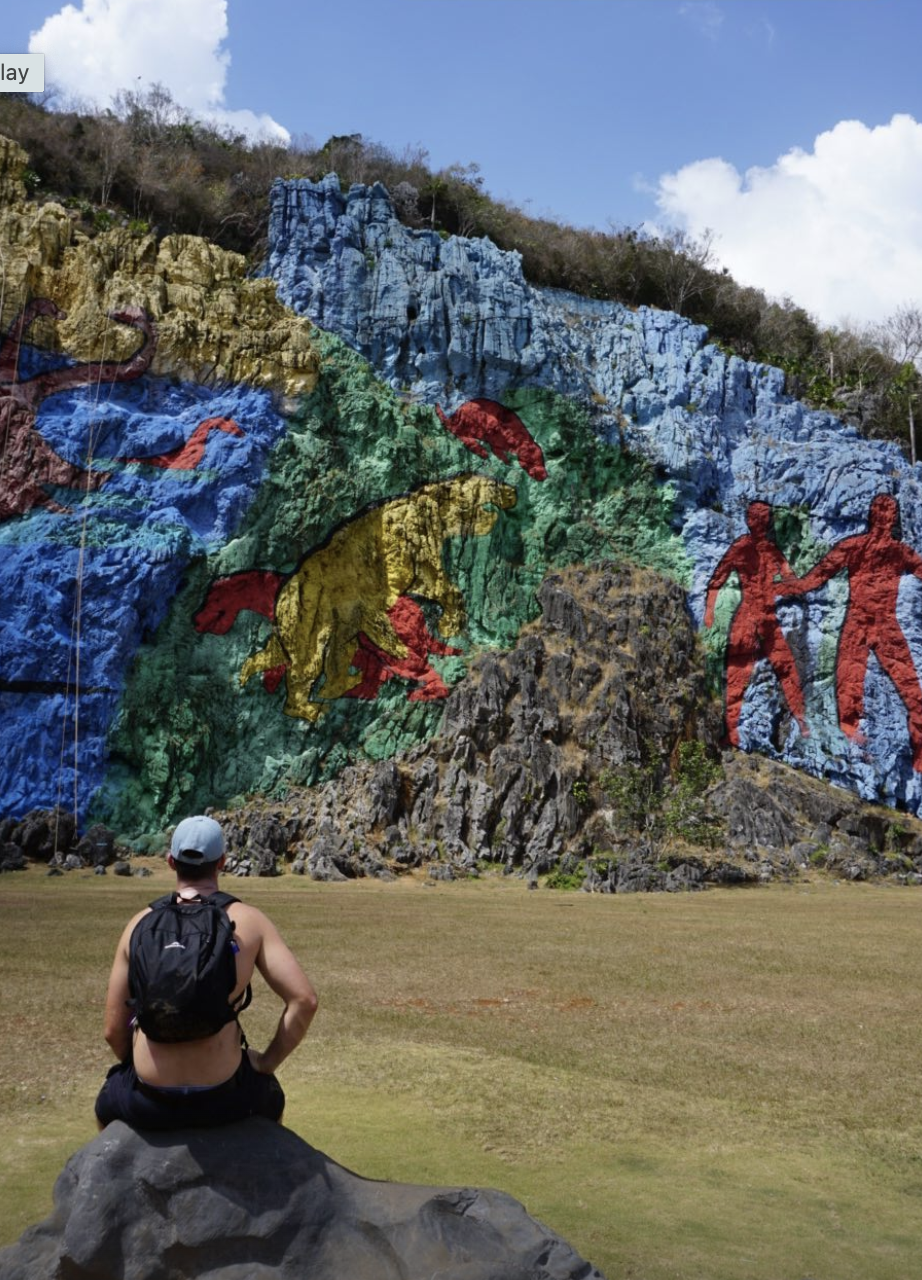
We followed the road 4km back into the town, and found somewhere to grab dinner before passing out that evening.
Travelling back to Havana
To get to Trinidad, we caught another bus back to Havana, where we stayed the night again at Roberto’s hostel. The next morning we walked back to the bus station to catch the Viazul bus to Trinidad, 315km away on the southern coast of Cuba.
The next morning it was a fellow traveller Antonio’s birthday at the casa. At breakfast we celebrated with cake, cookies and the usual fruit and eggs.
Travel to Trinidad
We caught the 1:30pm Viazul bus from Havana to Trinidad, and arrived around 8pm. Thousands of crabs were scuttling across the road as we entered Trinidad. This time, Roberto hooked us up with a casa in Trinidad. His friend Douglas puts travellers up in his beautiful two-storey home, which is about a 20 minute walk from the main plaza. Douglas met us at the bus stop and we all hopped into a tricycle taxi.
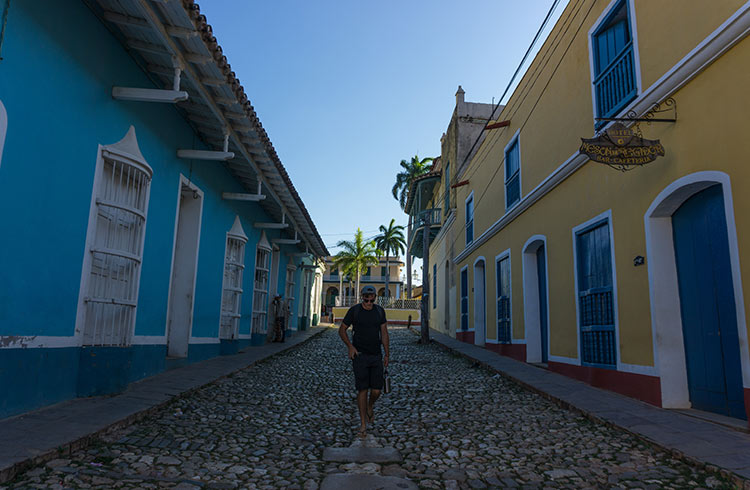
When we arrived at Douglas’ home, clean towels sat on our bed in the shape of a swan.
The next morning Douglas handed us each a coffee in purple and white mugs. We walked into town to find a cafe, where we were served a muffin with our second coffee. We found a bike rental place that offered bikes for 6CUC a day per bike.
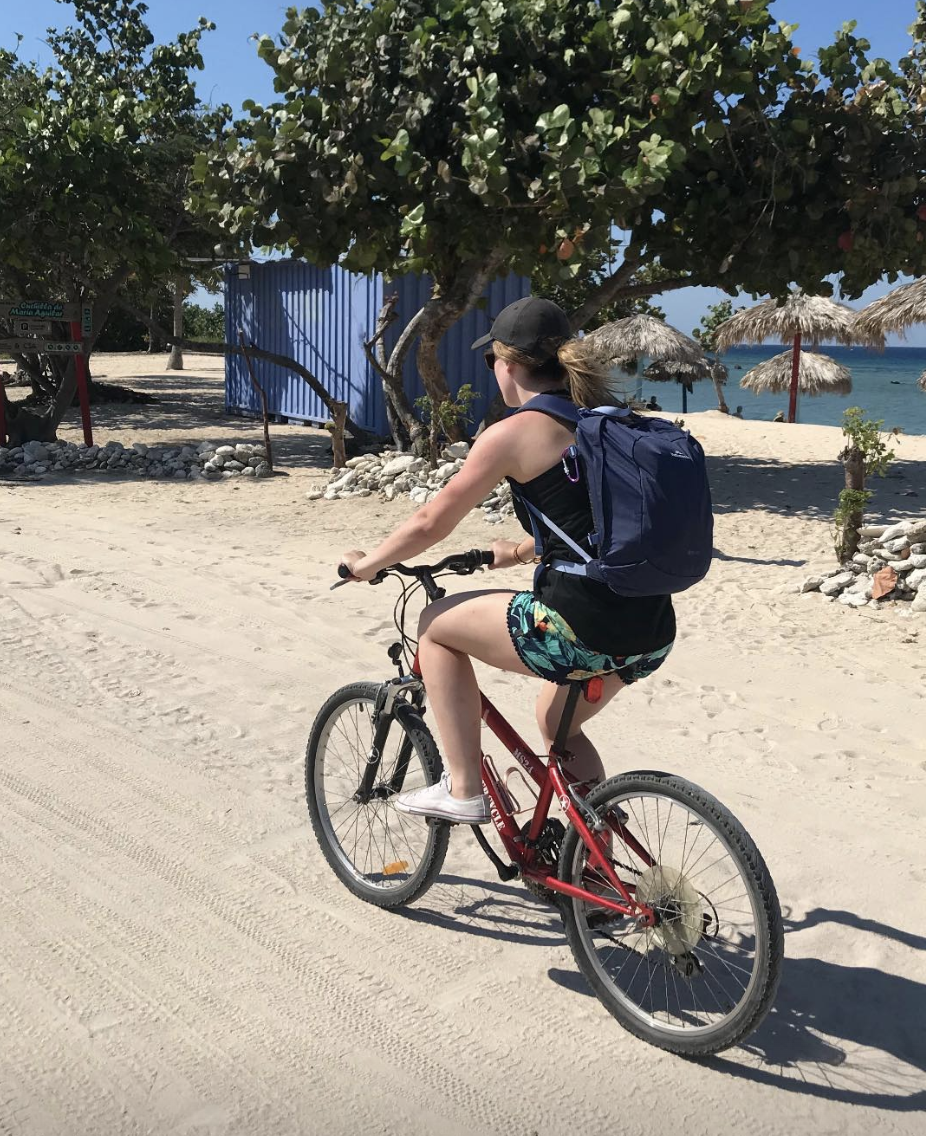
We took off on the bikes, where we stopped at La Boca first for a quick rest. We continued another 8.8km to Playa Ancon.
At Playa Ancon we paid 2CUC for bicycle parking. There are small huts where you can get changed, and I accidentally left my underpants in there. A man came over to tell me I’d forgotten something, acting out putting underpants on to help with the language barrier. I quickly realised he was right, and bolted back to grab my underwear.
We paid 2CUC each for a chair, and got two pizzas for 6CUC.
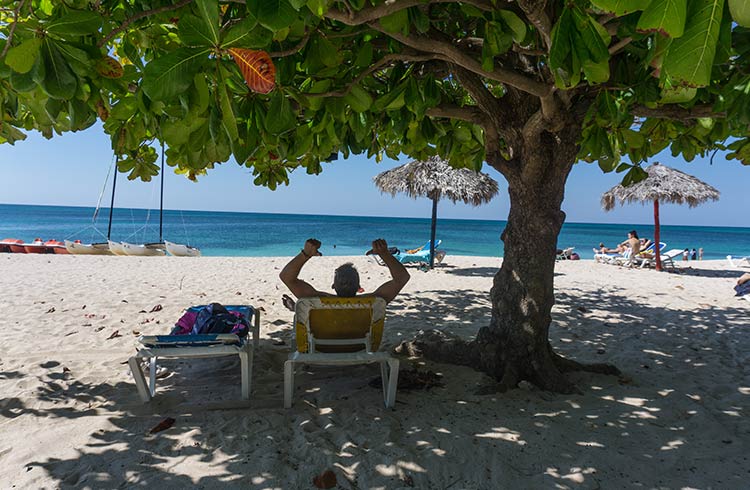
On the 2 hour, 13km ride back to Trinidad that afternoon we went past the airport for a change of scenery.
We went to La Esquina cafe for dinner in Trinidad plaza.
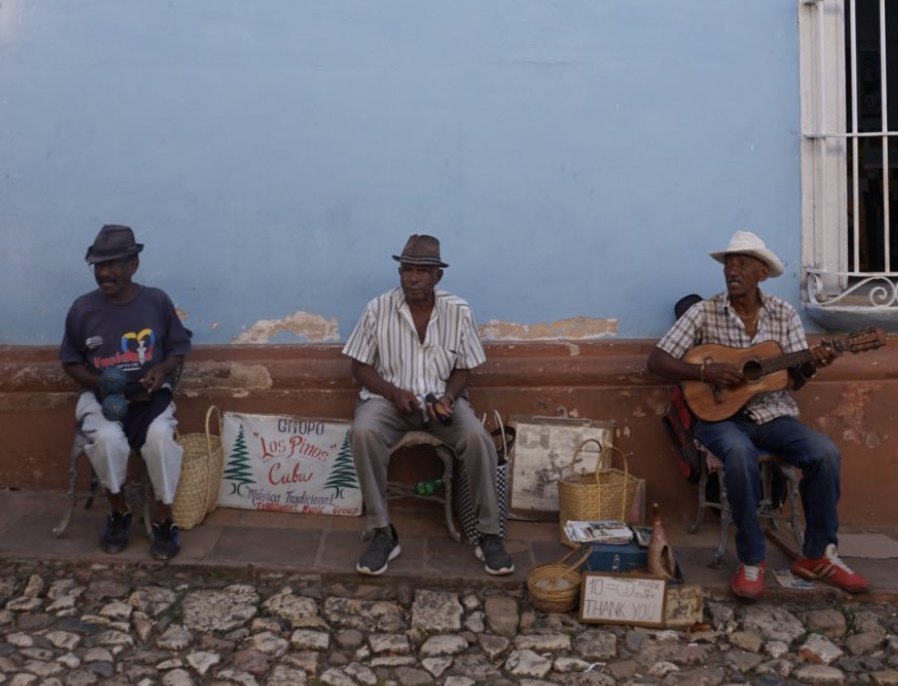
The next morning we caught the Viazul from Trinidad to Havana at 10am. The bus stopped twice just outside Trinidad, where we saw the driver running back to the bus with a container of milk and two trays of eggs. The second time he stopped he left the bus with a giant baguette and returned with a small bottle of alcohol.
That night back in Havana, we walked from the hostel to Fabrica de Arte Cubano, but when we got there the line was incredibly long, and it was already late. We decided to walk back home to get a good nights sleep.
Old Havana
On our last day in Cuba, we woke to Roberto making us breakfast again. We had guava, watermelon, fried eggs, fried banana, bread and tomato.
At 8:30am we left the hostel to begin the 6.5km walk to Old Havana, via the Malecon. At the end of the Malecon there are cannons and an old castle. We saw a man throw his dog in the water to wash him.
We bought some pastries and a coffee at Pasteleria in the main quarter of Old Havana.
From Capitolo we walked to Plaza Vieja, and then to the Rum Museum.
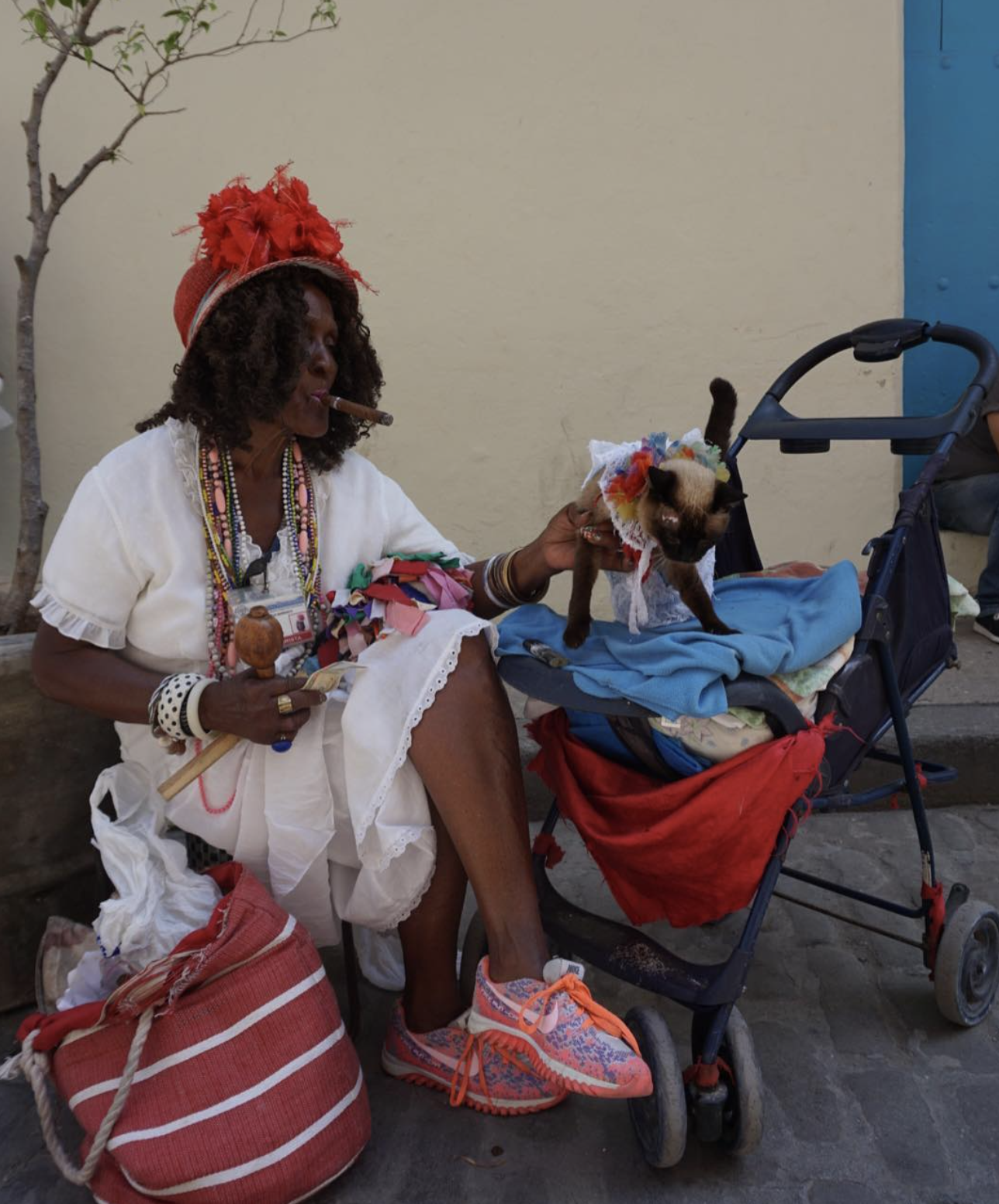
On our way back to the hostel, we saw a barber working out of his garage. Mark suddenly felt the need to get a hair cut, and was given the best trim of his life.
That night we ordered a taxi to take us to the airport for our flight to Peru. When the taxi turned up, it needed hot wiring to get started again. The rattling of the car sounded like it was going to fall apart as we zoomed along the main roads in the night.
As we got close to the airport we could hear a scream coming from a motorbike beside the car. Two sets of traffic lights later we could see the man riding the motorbike was holding a chicken by the neck.
One day I hope to return to Cuba with our daughter. Have things changed since we visited in 2018? Let us know about your experience in the comments section!
*I sound like I'm whinging. I'm all for paying locals to guide me around, but we also just like to go hiking alone. We successfully blazed a trail through the valley, and you can too.
This post contains affiliate links.
January 16, 2024
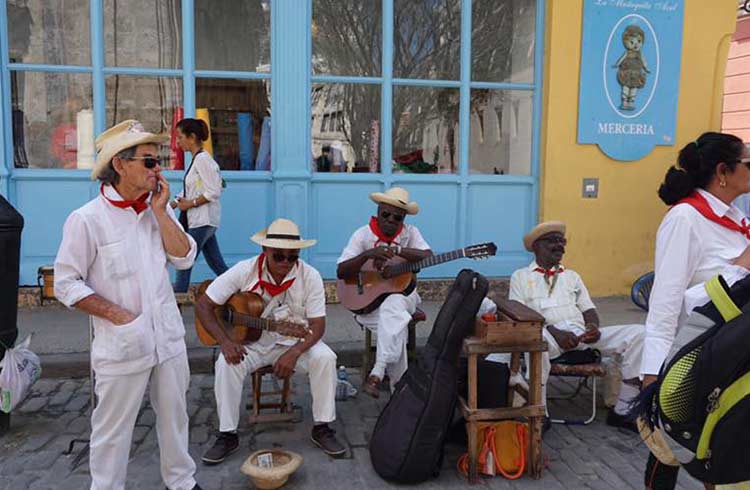
Join the discussion!